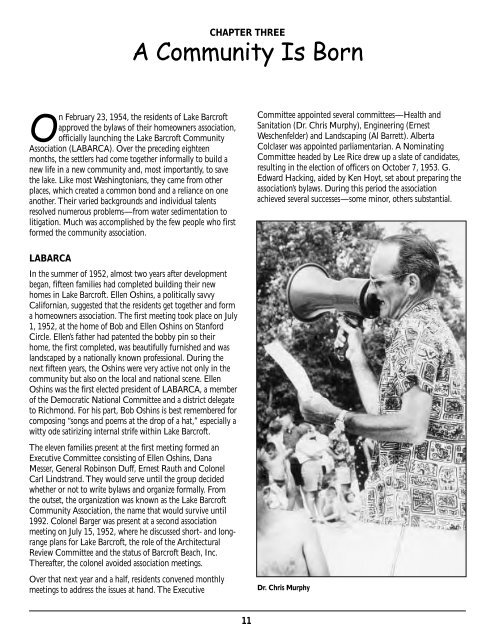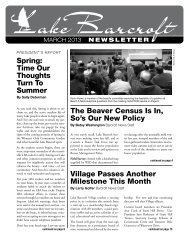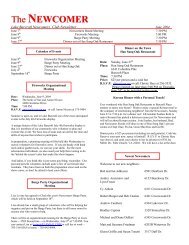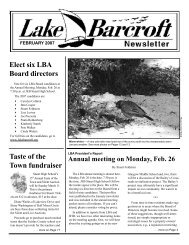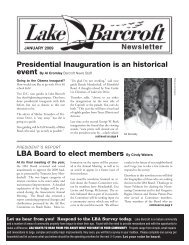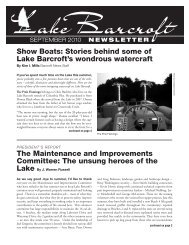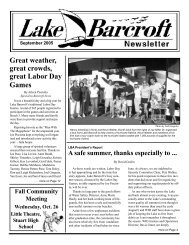Lake Barcroft History Book
Lake Barcroft History Book
Lake Barcroft History Book
Create successful ePaper yourself
Turn your PDF publications into a flip-book with our unique Google optimized e-Paper software.
On February 23, 1954, the residents of <strong>Lake</strong> <strong>Barcroft</strong><br />
approved the bylaws of their homeowners association,<br />
officially launching the <strong>Lake</strong> <strong>Barcroft</strong> Community<br />
Association (LABARCA). Over the preceding eighteen<br />
months, the settlers had come together informally to build a<br />
new life in a new community and, most importantly, to save<br />
the lake. Like most Washingtonians, they came from other<br />
places, which created a common bond and a reliance on one<br />
another. Their varied backgrounds and individual talents<br />
resolved numerous problems—from water sedimentation to<br />
litigation. Much was accomplished by the few people who first<br />
formed the community association.<br />
LABARCA<br />
In the summer of 1952, almost two years after development<br />
began, fifteen families had completed building their new<br />
homes in <strong>Lake</strong> <strong>Barcroft</strong>. Ellen Oshins, a politically savvy<br />
Californian, suggested that the residents get together and form<br />
a homeowners association. The first meeting took place on July<br />
1, 1952, at the home of Bob and Ellen Oshins on Stanford<br />
Circle. Ellen’s father had patented the bobby pin so their<br />
home, the first completed, was beautifully furnished and was<br />
landscaped by a nationally known professional. During the<br />
next fifteen years, the Oshins were very active not only in the<br />
community but also on the local and national scene. Ellen<br />
Oshins was the first elected president of LABARCA, a member<br />
of the Democratic National Committee and a district delegate<br />
to Richmond. For his part, Bob Oshins is best remembered for<br />
composing “songs and poems at the drop of a hat,” especially a<br />
witty ode satirizing internal strife within <strong>Lake</strong> <strong>Barcroft</strong>.<br />
The eleven families present at the first meeting formed an<br />
Executive Committee consisting of Ellen Oshins, Dana<br />
Messer, General Robinson Duff, Ernest Rauth and Colonel<br />
Carl Lindstrand. They would serve until the group decided<br />
whether or not to write bylaws and organize formally. From<br />
the outset, the organization was known as the <strong>Lake</strong> <strong>Barcroft</strong><br />
Community Association, the name that would survive until<br />
1992. Colonel Barger was present at a second association<br />
meeting on July 15, 1952, where he discussed short- and longrange<br />
plans for <strong>Lake</strong> <strong>Barcroft</strong>, the role of the Architectural<br />
Review Committee and the status of <strong>Barcroft</strong> Beach, Inc.<br />
Thereafter, the colonel avoided association meetings.<br />
Over that next year and a half, residents convened monthly<br />
meetings to address the issues at hand. The Executive<br />
CHAPTER THREE<br />
A Community Is Born<br />
11<br />
Committee appointed several committees—Health and<br />
Sanitation (Dr. Chris Murphy), Engineering (Ernest<br />
Weschenfelder) and Landscaping (Al Barrett). Alberta<br />
Colclaser was appointed parliamentarian. A Nominating<br />
Committee headed by Lee Rice drew up a slate of candidates,<br />
resulting in the election of officers on October 7, 1953. G.<br />
Edward Hacking, aided by Ken Hoyt, set about preparing the<br />
association’s bylaws. During this period the association<br />
achieved several successes—some minor, others substantial.<br />
Dr. Chris Murphy


